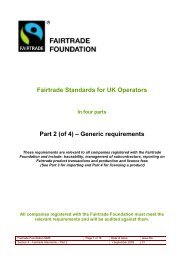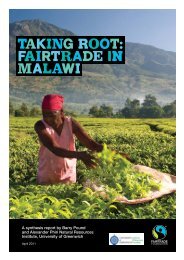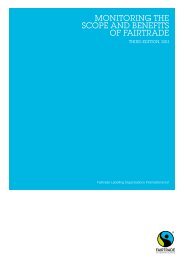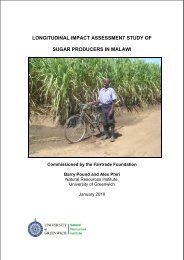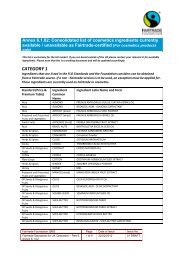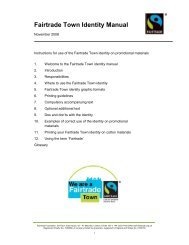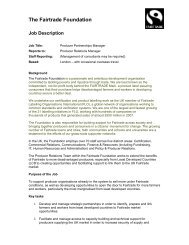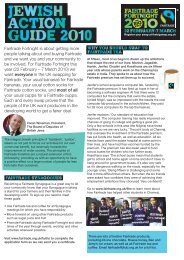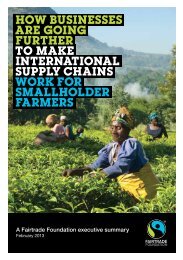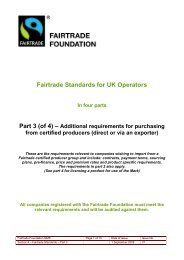Fairtrade and Coffee Report 2012 - The Fairtrade Foundation
Fairtrade and Coffee Report 2012 - The Fairtrade Foundation
Fairtrade and Coffee Report 2012 - The Fairtrade Foundation
You also want an ePaper? Increase the reach of your titles
YUMPU automatically turns print PDFs into web optimized ePapers that Google loves.
3. WHy fairtrade Is needed…<br />
In addition to fluctuating prices <strong>and</strong> domination of<br />
the supply chain by a few large multinationals, there<br />
are many other challenges facing the average coffee<br />
producer. <strong>Coffee</strong> farmers typically subsist on less<br />
than $2 a day, growing food crops such as maize <strong>and</strong><br />
supplementing their income from coffee with cash<br />
crops such as bananas, rearing livestock, casual<br />
labour <strong>and</strong> running small businesses. <strong>The</strong>ir farms are<br />
located in remote rural areas with increasingly erratic<br />
climatic conditions. Arabica production, in particular,<br />
tends to be located in mountainous areas away from<br />
paved roads, accessible only on foot or horseback<br />
by tracks susceptible to flooding, <strong>and</strong> where there<br />
is often little government investment in education,<br />
healthcare, transport, or the provision of clean water<br />
<strong>and</strong> access to electricity.<br />
3.1 Rising farm <strong>and</strong> household costs<br />
<strong>Coffee</strong> farmers endure a precarious existence faced<br />
with rising costs for food, fuel, transport <strong>and</strong> basic<br />
household necessities as well as school fees <strong>and</strong><br />
medical bills. <strong>The</strong> record high prices for wheat, maize,<br />
rice <strong>and</strong> other staple foods following the 2008 global<br />
financial crisis were topped in February 2011 when<br />
agricultural production was disrupted by severe<br />
weather. According to the FAO, ‘the cost of basic food<br />
staples remains high in many developing countries,<br />
making life difficult for the world’s poorest people<br />
who already spend between 60 <strong>and</strong> 80 per cent of<br />
their meagre income on food’. 34 <strong>The</strong> costs of key farm<br />
inputs such as labour, fertilisers <strong>and</strong> pesticides are<br />
also rising – fertilisers were 43 per cent higher in 2011<br />
than 2010 35 – <strong>and</strong> farmers lack the capital or access to<br />
affordable credit to invest in improving production or<br />
combating pests <strong>and</strong> disease.<br />
3.2 Lack of technical support<br />
Many individual coffee farmers survive on low incomes<br />
<strong>and</strong> remain trapped in poverty because of their small<br />
plots <strong>and</strong> low crop yields. Without access to technical<br />
agronomic support they are unable to boost incomes<br />
by increasing productivity or improving quality by<br />
replacing old trees or by planting hybrid varieties<br />
suited to changing climatic conditions.<br />
34 FAO Initiative on Soaring Food Prices<br />
http://www.fao.org/isfp/isfp-home/en/<br />
35 Global Economic Prospects January <strong>2012</strong>, Global Commodity Market<br />
Outlook, World Bank<br />
3.3 Weak negotiating position<br />
Poor access to information about prices <strong>and</strong> markets<br />
makes those small farmers not organized in producer<br />
co-operatives vulnerable to local dealers to whom<br />
they typically sell their crop as soon as it is harvested<br />
(since they tend to lack storage facilities); they have<br />
little bargaining power with which to get a better price.<br />
3.4 Climate change,<br />
adaptation <strong>and</strong> diversification<br />
Climate change related to global warming is a real<br />
<strong>and</strong> growing threat to the livelihoods of thous<strong>and</strong>s<br />
of coffee farmers. <strong>The</strong>y will have to implement<br />
appropriate adaptation <strong>and</strong> mitigation strategies<br />
to maintain their yields <strong>and</strong> incomes, such as<br />
supplementary irrigation, more efficient on-farm<br />
processing, <strong>and</strong> better farming practices such as<br />
terracing <strong>and</strong> planting shade trees to conserve water<br />
<strong>and</strong> soil moisture. In practice, many farmers will need<br />
financial <strong>and</strong> technical support to implement these<br />
measures which, in themselves, are also likely to<br />
increase their costs of production.<br />
Farmers will rely on scientists to develop drought <strong>and</strong><br />
disease resistant coffee varieties <strong>and</strong> will also need<br />
external support for longer-term strategies such as<br />
capacity building <strong>and</strong> diversification – in extreme<br />
cases, production may have to shift to higher altitudes<br />
with the right soil type <strong>and</strong> where there is adequate<br />
infrastructure.<br />
This is not a realistic option for most coffee farmers,<br />
who instead may have to look at diversifying into other<br />
crops or activities. Diversification out of coffee is a<br />
risky strategy for smallholders constrained by a lack<br />
of l<strong>and</strong>, finance <strong>and</strong> training. It is vital that they are<br />
provided with detailed market information, business<br />
support <strong>and</strong> training to devise a viable business plan.<br />
12 <strong>Fairtrade</strong> <strong>and</strong> <strong>Coffee</strong>



